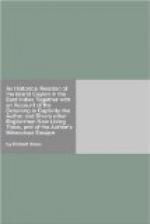[How they unhusk their Rice.] They unshale their Rice from its outward husk by beating it in a Mortar, or on the Ground more often; but some of these sorts of Rice must first be boyled in the husk, otherwise in beating it will break to powder. The which Rice, as it is accounted, so I by experience have found, to be the wholsomest; This they beat again the second time to take off a Bran from it; and after that it becomes white. And thus much concerning Rice-Corn.
[Other sorts of Corn among them.] Besides this, tho far inferior to it, there are divers other sorts of Corn, which serve the People for food in the absence of Rice, which will scarcely hold out with many of them above half the Year. [Coracan.] There is Coracan, which is a small seed like Mustard-seed, This they grind to meal or beat in a Mortar, and so make Cakes of it, baking it upon the Coals in a potsheard, or dress it otherwise. If they which are not used to it, eat it, it will gripe their Bellies; When they are minded to grind it, they have for their Mill two round stones, which they turn with their hands by the help of a stick: There are several sorts of this Corn. Some will ripen in three months, and some require four. If the Ground be good; it yields a great encrease; and grows both on the Hills and in the Plains. [Tanna.] There is another Corn called Tanna; It is much eaten in the Northern Parts, in Conde Uda but little sown. It is as small as the former, but yieldeth a far greater encrease. From one grain may spring up two, three, four or five stalks, according as the ground is, on each stalk one ear, that contains thousands of grains. I think it gives the greatest encrease of any one feed in the World. Each Husbandman sowes not above a Pottle at a Seeds-time. It growes up two foot, or two foot and an half from the ground. The way of gathering it when ripe, is, that the Women (whose office it is} go and crop off the ears with their hands, and bring them home in baskets. They onely take off the ears of Coracan also, but they being tough, are cut off with knives. This Tanna must be parched in a Pan, and then is beaten in a Mortar to unhusk it. It will boyl like Rice, but swell far more; the tast not bad but very dry, and accounted wholsome; the fashion flattish, the colour yellow and very lovely to the Eye. It ripens in four months, some sorts of it in three. There are also divers other sorts, which grow on dry Land (as the former) and ripen with the Rain. [Moung.] As Moung, a Corn somewhat like Vetches, growing in a Cod. [Omb.] Omb, a small seed, boyled and eaten as Rice. It has an operation pretty strange, which is, that when it is new it will make them that eat it like drunk, sick and spue; and this only when it is sown in some Grounds, for in all it will not have this effect: and being old, none will have it. Minere, a small seed. Boumas, we call them Garavances. Tolla, a seed used to make Oyl, with which they anoint themselves; and sometimes they will parch it and eat it with Jaggory, a kind of brown Sugar. And thus much of their Corn.




